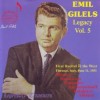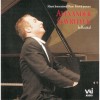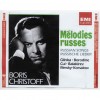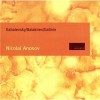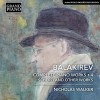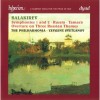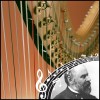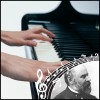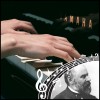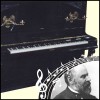| Country: | Russia |
| Period: | Russian classics |
Biography
Life
Mikhail Glinka encouraged Balakirev to follow a career in music. His own efforts at Russian nationalism in music deeply influenced the young composer.
Early years
Balakirev was born at Nizhny Novgorod into a poor clerk's family. He received his first lessons in music from his mother and at the age of four was able to reproduce tunes on the piano. His non-musical eduucation began at the Nizhky Novgorod Gymnasium. When he was ten his mother took him to Moscow during the summer holidays for a course of ten piano lessons with Alexander Dubuque, a pupil of Irish pianist and composer John Field. After his mother's death, Balakirev was transferred from the Gymnasium to the Alexandrovsky Institute, where he boarded. Balakirev's musical talents did not remain unnoticed, as he soon found a patron in nobleman Alexander Oulibichev. Oulibichev was considered the leading musical figure and patron in Nizhny Novgorov; he owned a vast musical library and had authored a biography of Wolfgang Amadeus Mozart.
Balakirev's musical education was placed in the hands of pianist Karl Eisrach, who also arranged the regular musical evenings at the Oulibichev estate. Through Eisrach, Balakirev was given opportunities to read, play and listen to music and was exposed to the music of Frederic Chopin and Mikhail Glinka. Eisrach and Oulibichev also allowed Balakirev to rehearse the count's private orchestra in orchestral and choral works. Eventually, Balakirev led a performance, at age 14, Mozart's Requiem. At 15 he was allowed to rehearse Ludwig van Beethoven's First and Eighth Symphonies His earliest surviving compositions date from the same year—the first movement of a septet for flute, clarinet, piano and strings and a Grande Fantasie on Russian folksongs for piano and orchestra.
Balakirev left the Alexandrovsky Institute in 1853 and with his friend (and later novelist) P.D. Boborikin entered the University of Kazan as a mathematics student. He was soon noted in local society as a pianist and was able to supplement his limited finances by taking pupils. His holidays were spent either at Nizhny Novgorod or on the Oulibichev country estate at Lukino, where he played numerous Beethoven sonatas to help his patron with his book on the composer. From this period date the piano fantasy based on themes from Glinka's opera A Life for the Tsar, an attempt at a string quartet, three songs which would eventually be published in 1908 and the opening movement (the only one completed) of his First Piano Concerto.
After Balakirev completed his courses in the late autumn of 1855, Oublichev took him to Saint Petersburg, where Balakirev met Glinka. While Glinka considered Balakirev's compositional technique defective (there were as yet no music textbooks in Russian and Balakirev's German was barely adequate), he thought highly of his talent, encouraging him to take up music as a career. Their acquaintance was marked by discussions, by Glinka passing several Spanish musical themes to Balakirev, and with Glinka entrusting the young man with the musical education of his four-year-old niece. He made his debut in a university concert in February 1856, playing the completed movement from his First Piano Concerto. This was followed a month later with a concert of his piano and chamber compositions. In 1858 he played the solo part in Beethoven's Emperor Concerto before the tsar. In 1859 he had 12 songs published. Nevertheless, he was still in extreme poverty, supporting himself mainly by giving piano lessons (sometimes nine a day) and by playing at soirees given by the aristocracy.
"The Five"
The deaths of Glinka in 1857 and Oublichev the following year left Balakirev without influential supporters. Nevertheless, his time with Glinka had sparked a passion for Russian nationalism within Balakirev, leading him to adopt the stance that Russia should have its own distinct school of music, free from Southern and Western European influences. He had also started meeting other important figures who would abet him in this goal in 1856, including César Cui, Alexander Serov, the Stasov brothers and Alexander Dargomizhsky. He now gathered around him composers with similar ideals, whom he promised to train according to his own principles. These included Modest Mussorgsky in 1858; Nikolai Rimsky-Korsakov in November 1861 and Alexander Borodin in November or December 1862. Together with Cui, these men were described by noted critic Vladimir Stasov as "a mighty handful;" they eventually became better known in English simply as "The Five."
As an instructor and influence of magnetic personality, Balakirev inspired his comrades to improbable heights of musical creativity. However, he vehemently opposed academic training, considering it a threat to the musical imagination. It was better in his view to begin composing right away and learn through that act of creation. This line of reasoning could be argued as a rationalization to his own lack of technical training. He had been trained as a pianist and had to discover his own way to becoming a composer. Rimsky-Korsakov eventually realized as much but still gave Balakirev his due:
Balakirev, who had never had any systematic course in harmony and counterpoint and had not even superficially applied himself to them, evidently thought such studies quite unnecessary.... An excellent pianist, a superior sight reader of music, a splendid improvisor, endowed by nature with a sense of correct harmony and part-writing, he possessed a technique partly native and partly acquired through a vast musical erudition, with the help of an extraordinary memory, keen and retentive, which means so much in steering a critical course in musical literature. Then, too, he was a marvelous critic, especially a technical critic. He instantly felt every technical imperfection or error, he grasped a defect in form at once.
Balakirev instructed the other members of "The Five" much as he instructed himself—by an empirical approach, sifting through scores of the great composers. About this Rimsky-Korsakov was more critical:
With all his native mentality and brilliant abilities, there was one thing he failed to understand: that what was good for him in the matter of musical education was of no use whatsoever for others, as these others not only had grown up amid entirely different surroundings, but possessed utterly different natures; that the development of their talents was bound to take place at different intervals and in a different manner.
Balakirev had the musical experience that the others in The Five lacked. They listened avidly to his views and followed his advice scrupulously. This did not stop his influence from varying from one person to the next. He was on friendly terms with Cui and, for a while, with Mussorgsky—until Mussorgsky started to follow his own precepts and not Balakirev's, losing Balakirev's sympathy in the process. He held little sway control over Borodin, who kept his distance and made no secret that music would always remain a pastime for him. His authority remained strongest over Rimsky-Korsakov.
Balakirev's eventual undoing was his demand that his students' musical tastes coincide exactly with his own. Even the slightest deviation was prohibited. Whenever someone played one of his own compositions for Balakirev, Balakirev would seat himself at the piano and improvise, showing how the composition should be changed. Passages in other people's works came out sounding like his music, not their own. For a while he was obeyed absolutely.
Mature composer
The 1860s proved a time of great activity for Balakirev. In 1866, his Collection of Russian Folksongs were published. These arrangements showed great insight into the rhythm, harmony and types of song, although the key signatures and elaborate textures of the piano accompaniments were not as idiomatic. Holidays in the Caucasus in 1862, 1863 and 1868 had opened Balakirev's ears to the folk tunes of that region and would prove an important source for his own compositions, especially Islamey. He also encouraged Rimsky-Korsakov and Borodin to complete their first symphonies, whose premieres he conducted in December 1865 and January 1869 respectively. he also conducted the first performance of Mussorgsky's The Destruction of Sennacherib in March 1867 and the Polonaise from Boris Godunov in April 1872.
Even at this point, however, Balakirev had trouble finishing large works. He began a second piano concerto in the summer of 1861, with a slow movement thematically connected with a requiem that occupied him at the same time. He did not finish the opening movement until the following year, then set aside the work for 50 years. He suffered from periods of acute depression, longed for death and thought about destroying all his manuscripts. He was still able to complete some works quickly. He began the original version of Islamey in August 1869, finishing it a month later. Nikolay Rubinstein premiered the "oriental fantasy," which Balakirev considered a sketch for his symphonic poem Tamara, that December.
Free School of Music
The early years of the reign of Tsar Alexander II, which paralleled the creation of The Five, ushered in a political climate favorable to innovation and reform. The results in music were the establishment of the Russian Musical Society (RMS) and the musical conservatories in St. Petersburg and Moscow. While these institutions had powerful champions in the form of Anton and Nikolai Rubinstein, there were also those who were fearful of the consequences of introducing German instructors and musical precepts into Russia. Balakirev's sympathies and closest contacts were in the latter camp, and he frequently made derogatory comments about the German "routine" which, he believed, came at the expense of the composer's originality. The pro-Conservatory followers publicly called The Five "amateurs" (something that was not entirely unjustified, as Balakirev was the only professional musician of the group). To counteract these criticisms and to aid in the creation of a distinctly "Russian" school of music, the group founded the Free School of Music in 1862.
Like the RMS, the Free School offered concerts as well as education. Unlike the RMS, the Free School offered music education at no charge to students, in contrast to the expense of a Conservatory education. The school also emphasized singing, especially choral singing, to meet the demands of the Russian Orthodox Church. The initial idea for the school was Balakirev's. However, Gavriil Lomaken, a noted choirmaster, was appointed director, with Balakirev serving as his assistant. Between 1862 and 1867 Balakirev conducted orchestral concerts for the school and Lomankin conducted choral ones. These concerts offered less conservative programming than the Russian Musical Society concerts. They included the music of Hector Berlioz, Robert Schumann and Franz Liszt, Russian composers Mikhail Glinka and Alexander Dargomyzhsky, along with the first works of The Five.
Waning influence
When Anton Rubinstein relinquished directorship of the RMS concerts in 1867, Balakirev was suggested to replace him. The conservative patron for the RMS, Grand Duchess Elena Pavlovna, agreed—provided Nikolai Zaremba, who had taken over for Rubinstein at the Saint Petersburg Conservatory was also appointed, along with a distinguished foreign composer. The foreign composer chosen was Hector Berlioz. The choice of Berlioz was widely lauded. Balakirev's appointment was seen less enthusiastically. Balakirev's uncompromising nature caused tension at the RMS. His choice of modern repertoire for the RMS concerts earned him the enmity of Pavlovna, as well. In 1869, she informed him that his services were no longer required.
Balakirev's influence over the other members of "The Five" also began to wane. Mussorgsky and Rimsky-Korsakov stopped accepting what they now considered his high-handed meddling with their work. Stasov also began to distance himself from Balakirev.
Tchaikovsky at the time he met Balakirev.
Tchaikovsky
The week after Balakirev's dismissal, an impassioned article in his defense appeared in The Contemporary Chronicle. The author was Pyotr Ilyich Tchaikovsky. Balakirev had conducted Tchaikovsky's Fatum and his "Characteristic Dances" from Voyevoda at the RMS. Fatum had, in fact, been dedicated to Balakirev. To be fair, though, Tchaikovsky's move may have been at least partly calculated. He knew Elena Pavlovna was due in Moscow, where he lived, the day the article was to appear. He sent a note to Balakirev, alerting him to this fact. Accompanying it was a second note, thanking Balakirev for criticisms he had made about Fatum just after conducting it. Balakirev's immediate response was positive and enthusiastic.
This exchange of letters grew into both a long-term friendship and, over the next two years, a creative collaboration. Balakirev helped Tchaikovsky produce his first masterpiece, the fantasy-overture Romeo and Juliet. The subject was Balakirev's idea. The birthing process proved both hard and protracted. Not happy with some of Tchaikovsky's initial efforts, Balakirev pushed him for better music and offered further suggestions. Though its first performance was a failure, Romeo would soon bring Tchaikovsky his first national and inrternational acclaim. It would also become a work The Five lauded unconditionally. On hearing the love theme from Romeo, Stasov told the group, "There were five of you: now there are six."
After Romeo and Juliet, the two men drifted apart as Balakirev took a sabbatical from the music world (more below). In 1880, Balakirev received a copy of the final version of the score of Romeo from Tchaikovsky, care of the music publisher Besel. Delighted Tchaikovsky had not forgotten him, he replied with an invitation for Tchaikovsky to visit him in Saint Petersburg. In the same letter, he forwarded "the programme for another symphony which you would handle wonderfully well." This programme, originally penned by Stasov for Hector Berlioz, was based on Lord Byron's Manfred. Tchaikovsky intitally said no. Balakirev refused to take no for an answer and continued to encourage Tchaikovsky to "make an effort." Two years later, Tchaikovsky changed his mind. His Manfred Symphony, which he would finish in 1885, would become the largest, most complex work he had yet written. As with Romeo and Juliet and Fatum, Tchaikovsky dedicated the Manfred Symphony to Balakirev.
Breakdown
When Lomakin resigned as director of the Free Music School in February 1868, Balakirev took his place there. Once he had left the RMS, he concentrated on building attendance for concerts of the Free Music School. He decided to recruit popular soloists and found Nikolai Rubinstein ready to help. Elena Pavlovna was furious. She decided to raise the social level of the RMS concert by attending them personally with her court.
This rivalry caused financial difficulties for both concert societies. RMS membership declined. The Free School continued to suffer from chronic money troubles. Soon the Free Music School could not pay Balakirev. Its 1870-71 series had to be cut short. The RMS then scored the coup de grâce of assigning its programming to Mikhaíl Azanchevsky, who took over as director of the Saint Petersburg Conservatory in 1871. Azanchevsky was more progressively-minded than his predecessors. He was a staunch believer in contemporary music on the whole and Russian contemporary music in particular. For the opening concert of the RMS 1871-72 season, conductor Eduard Nápravník, presented the first public performances of Tchaikovsky's Romeo and Juliet and the polonaise from Mussorgsky's Boris Godunov. This kind of programming made Balakirev's concerts unnecessary and redundant.
These problems drove Balakirev to a nervous breakdown in 1872. He took a break from the musical world, which eventually lasted five years, but neglected to give up his post as director of the Free Music School. He finally resigned in 1874 and was replaced by Rimsky-Korsakov. Financial distress forced Balakirev to become a railway clerk on the Warsaw railroad line. Disillusioned, exhausted and suffering from bouts of deep depression, he sought solace in the strictest sect of Russian Orthodoxy.
Return to music
In 1876, Balakirev slowly began reemerging into the music world, but without the intensity of his former years. Stasov wrote Rimsky-Korsakov in July that Balakirev was busy composing his symphonic poem Tamara but still did not wish to see any of his old musical circle, "for there would be talks about music, which he would not have under any circumstances. Nevertheless he inquires about everything with interest...." Balakirev also began sending individuals to Rimsky-Korsakov for private lessons in music theory. This paved the way for Rimsky-Korsakov to make occasional visits to Balakirev. By the autumn these visits had become frequent. Also, Shestarova asked him to edit Glinka's works for publication.
By the 1880s, Balakirev had resumed his musical activities. After holding several jobs, such as that of a school inspector, he was appointed director of the Imperial Chapel and conductor of the Imperial Musical Society in 1883. He held this post until 1895, when he took his final retirement. He also composed in earnest. In 1882 he finished Tamara and revised his "symphonic picture" 1,000 Years two years later, retitling it Rus. Between 1895 and 1910 he completed two symphonies, a piano sonata and two movements of his Second Piano Concerto, along with republishing his collection of folk-song arrangements. Unlike his earlier days, Balakirev composed in isolation, aware that younger composers now considered his compositional style old-fashioned.
Balakirev died on May 29, 1910 and was interred in Tikhvin Cemetery at the Alexander Nevsky Monastery in Saint Petersburg.
Music
Balakirev became important in the history of Russian music through both his works and his leadership. More so than Glinka, he helped set the course for Russian orchestral music and Russian lyrical song during the second half of the 19th century. While he learned from Glinka certain methods of treating Russian folk song instrumentally, a bright, transparent orchestral technique (something he also learned from the works of Hector Berlioz) and many elements of his basic style, he developed and expanded upon what he had learned, fusing it satisfactorily with then-advanced Romantic compositional techniques.
Influences
Perhaps because Balakirev's initial musical experience was as a pianist, composers for his own instrument influences the repertory and style of his compositions. He wrote in all the genres cultivated by Frederic Chopin except the Ballade, cultivating a comparable charm. The other keyboard composer who influenced Balakirev was Franz Liszt, apparent in Islamey as well as in his transcriptions of works by other composers and the symphonic poem Tamara.
Balakirev's affinity with Glinka's music becomes most apparent in his handling of folk material. However, Balakirev advances on Glinka's technique of using "variations with changing backgrounds," reconciling the compositional practices of classical music with the ideomatic treatment of folk song, employing motivic fragmentation, counterpoint and a structure exploiting key relationships.
Between his two Overtures on Russian Themes, Balakirev became involved with folk song collecting and arranging. This work alerted him to the frequency of the Dorian mode, the tendency for many melodies to swing between the major key and its relative minor on its flat seventh key, and the tendency to accentuate notes not consistent with dominant harmony. These characteristics were reflected in Balakirev's handling of Russian folk song.
Since the musical views of The Five tended to be anti-German, it is easy to forget that Balakirev was actually well-grounded in German symphonic style—all the more impressive when it is remembered that Balakirev was essentially self-taught as a composer. His King Lear overture, written when he was 22, is not a symphonic poem in the vein of Liszt but actually more along the lines of Beethoven's concert overtures, relying more on the dramatic qualities of sonata form than on extramusical content.
Russian style: The Overtures
With his First Overture on Russian Themes, Balakirev began focusing on writing genuine Russian symphonic work with Russian character. He chose his themes from folk song collections available at the time he composed the piece, taking Glinka's Kamarinskaya as a model in taking a slow song for the introduction, then for the fast section choosing two songs compatible in structure with the ostinato pattern of the Kamarinskaya dance song. Balakirev's use of two songs in this section was an important departure from the model, as it allowed him to link the symphonic process of symphonic form with Glinka's variations on an ostinato pattern. This allowed Balakirev to treat the songs symphonically instead of merely decoratively.
The Second Overture on Russian Themes shows an increased sophistication as Balakirev utilizes Beethoven's technique of deriving short motifs from longer themes so that those motifs can be combined into a convincing contrapuntal fabric. As such it can stand on its own as an example of abstract motivic-thematic composition, yet since it uses folk songs in doing so, it can also be looked upon as making a statement about nationality. In this overture he shows how folk songs could be given symphonic dimensions while paying particular attention to the element of protyazhnaya or melismatically elaborated lyric song. This type of song is characterized by extreme rhythmic flexibility, asymmetrical phrase structure and tonal ambiguity. Incorporating these elements meant employing the tonal instability of folk song in larger structures by relying on tonal indeterminacy. The structure of this overture departs from the classic tonal relationships of tonic and dominant, coming close to the tonal experiments of Liszt and Robert Schumann.
Unlike his contemporaries in The Five, the musical form always came first for Balakirev, not the extramusical source, and his technique continued to reflect the Germanic symphonic approach. Nevertheless, Balakirev's overtures played a crucial role in the emergence of Russian symphonic music in that they introduced the musical style now considered "Russian." His style was adapted by his compatriots and others to the point of becoming a national characteristic. The opening of Mussorgsky's Boris Godoubov bears a close resemblance to the first theme of Balakirev's Second Overture, while Borodin's In the Steppes of Central Asia begins with a dominant pedal extending over 90 bars in the upper register of the violins, a device Balakirev used in his First Overture. The opening of Tchaikovsky's Little Russian Symphony also shows Balakirev's influence.
Progressive development: First Symphony
Balakirev began his First Symphony after completing the Second Overture but cut work short to concentrate on the Overture on Czech Themes, recommencing on the symphony only 30 years later and not finishing it until 1897. Letters from Balakirev to Stasov and Cui indicate that the first movement was two-thirds completed and the final movement sketched out, though he would supply a new theme for the finale many years later. While he was waiting until the finale to incorporate folk material, he was anxious to incorporate a new Russian element, somewhat religious in nature, into the opening movement The symphonic design for this movement is highly unusual. The slow introduction announces the motif on which the allegro vivo is based. While the allegro vivo is a three part structure, it differs from sonata form in having an exposition, a second exposition and a development instead of the usual order of exposition-development-recapitulation. This means that after the actual exposition, the thematic material is developed in two places, with the second exposition actually being an elaboration of the first. Formally, the process is one of progressive development, divided into three stages of increasingly complexity. If this was how Balakirev had actually planned the movement in 1864, it would predate the late symphonies of Jean Sibelius in utilizing this compositional principle.
Orientalism: Tamara
Balakirev also further cultivated the orientalism of Glinka's opera Ruslan and Lyudmila, making it a more consistent style. It appears in the Georgian Song of 1861, Islamey and Tamara. This style comprises two parts: a langorous vein of slow, sinuous melody with ornamentation and slow-moving harmonic progressions, contrasted with a more ecstatic vein marked by a perpetuum mobile at a fast tempo and rapid melodic contours over a slower-moving harmonic changes. This style on one hand evoked the mystery of the distant, exotic east with which Russia did not have direct contact, and on the other hand could also be used to refer to recently colonized areas of the Russian Empire.
Tamara may be considered Balakirev's greatest work as well as a touchstone of orientalism. Originally he intended to write a lezginka modeled after Glinka. However, he was inspired by the poetry of Mikhail Lermontov about the seductress Tamara, who waylays travelers in her tower at the gorge of Daryal and allows them to savor a night of sensual delights before killing them and flinging their bodies into the River Terek. Balakirev evokes both the poem's setting of the mountains and gorges of the Caucasus and the angelic and demonically seductive power of the title character. The narrative employs a wide musical range, with the composer supplying great subtlety within a satisfying structure.
Balakirev finished drafting Tamara in 1869 but did not complete the work until 1882, revising the orchestration in 1898. Rimsky-Korsakov's better-known symphonic suite Scheherazade, written in 1888, would prove greatly influenced by it.





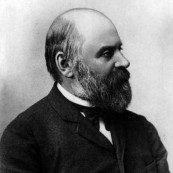

![Steinway Legends - Claudio Arrau [2 CD]](http://static.classicalm.com/repository/collection-cover/small/233-img1316815171145336.jpg)





